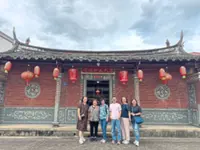Capt Ho (standing, second from right) beside his US superior during his first flight training in the United States. Photos: Capt Ho Weng Toh
“It was a hot sunny day with clear blue skies. My B-25 bomber was humming along nicely at 10,000ft while my co-pilot and I were monitoring our instruments and scanning the ground below. Suddenly, we saw a long column of Japanese soldiers with some cavalry troops on the ground below us.
“Without any hesitation, I flew my plane towards the Japanese and dropped bombs on them,” said Captain Ho Weng Toh.
The 103-year-old recounted to me the above – which took place during World War II – with a tinge of pride during a lunch in Singapore in March 2023.
Although he killed a few hundred Japanese soldiers that historical day, he felt it was a small act of justice for the terrible atrocities that the Japanese had committed, including the “Rape of Nanking”.
Captain Ho was born on March 21, 1920, in Ipoh. His father owned the Heng Woh shoe shop, which was the biggest shoe shop in Ipoh before the war, patronised by rich tin miners and British colonial officers.
Captain Ho was an accidental pilot. After finishing his studies at the illustrious St Michael’s Institution in Ipoh, he continued his education at the prestigious University of Hong Kong. However, his university education was halted due to the war.
After invading Hong Kong, the Japanese meted out cruel and harsh treatment to civilians in Hong Kong. Captain Ho‘s outrage was further fuelled by the atrocities committed by the Japanese army in China and Malaya.
Utterly disgusted, he told himself that he would seek some justice for the innocents who were raped, tortured or killed.
To escape Hong Kong, Captain Ho and his friends hatched a bold and risky plan to cross over a mountain to mainland China under the cover of darkness. They were fortuitous to meet and get a princely sum of $500 each from Aw Boon Haw, the founder of Tiger Balm. It would mean death for them and Aw if the Japanese army found out.
Two Japanese soldiers happened to pass by the fishing boat Captain Ho and his friends were hiding in. Miraculously though, in the end, he and his friends managed to reach China unscathed. Wasting no time, he quickly sat for an entrance examination to enrol as a trainee pilot to be a Flying Tiger.
The Flying Tigers were the first American Volunteer Group of the Republic of China’s Air Force under the command of US General Claire Chennault, the military aviation advisor to Generalissimo Chiang Kai-shek. Together with his fellow trainees, Captain Ho was sent to Arizona, in the United States, to undergo intensive pilot training.
They sailed on board the ocean liner RMS Queen Elizabeth – it was faster than the German warships. After a harrowing month at sea, they finally saw the Statue of Liberty in New York harbour. It was a memorable moment for him as it gave him hope that his dream of joining the Flying Tigers was within grasp.
After successfully completing his demanding training in the United States, he was commissioned to fly the B-25 bomber to fight against the Japanese in China during the war.
Shaking his head slowly during lunch, Captain Ho confided in me: “The saddest moments were seeing my fellow pilots going down with their planes in flames after they were hit by Japanese anti- aircraft guns. It was heartrending to see the reactions of the parents when I broke the news of their sons’ death to them.”
Despite the danger, Captain Ho carried out all his missions with unflinching courage and confidence. Thankfully, he always managed to land his bullet-ridden plane safely even after being shot at multiple times by the deadly Japanese “Zero” fighter planes.
After the war, China was embroiled in a turbulent civil war between the Chinese Communist Party (CCP) and Kuomintang (KMT, the Nationalist Party of China). Captain Ho was then flying evacuation flights operated by Central Air Transport Corporation (CATC), for Shanghai residents moving to Hong Kong.
At the lunch, Captain Ho, with knitted brow, said in a low voice: “During our church wedding, we could hear bomb explosions and artillery firing, besides the wedding bells!” He was worried that his first night of marriage might turn out to be the last for him and his wife. Fortunately, he managed to evacuate his wife and her family to the safety of Hong Kong in time.
After the communist takeover of China, all the CATC airplanes were grounded in Hong Kong. Following a tense standoff, many pilots flew their planes back to Beijing after the Qiyi or “Righteous Uprising” assurance given by Chinese Premier Zhou Enlai. This move upset the KMT government of Taiwan, which then sent their fighter jets to pursue the CATC planes. Thanks to providence, heavy cloud cover prevented the CATC planes from being shot down.
Refusing to be involved in a civil war between the CCP and Kuomintang, Captain Ho returned to Malaya and flew with the fledgling Malayan Airways (MA). He was among the first few pilots to fly to remote towns in Sabah and Sarawak.
After the separation of Singapore, Captain Ho continued his flying career with Singapore Inter-national Airlines (SIA). One of the memorable moments of his time at SIA was to evacuate the Catholic Bishop of Saigon just before the Fall of Saigon in 1975. As the battle was raging on around Saigon, he also worried about the MIG-21 fighter jets of the Vietnamese air force. Fortunately, he managed to fly off safely with the Bishop just before the city was overrun by the communists.
Another memorable occasion was the engine failure during his flight from Penang to Singapore in October 1961. After reassuring his crew and passengers with a calm and confident voice, he expertly steered his plane to land safely at Penang airport. His war experience as a Flying Tiger had prepared him well for this sort of eventuality.
During his career with MA and SIA, the pilot trainers were all western expatriates in the early years. Captain Ho was disheartened that they were bullying the local trainee pilots. He was also disappointed that the expatriate pilots enjoyed higher salaries although they did the same work as local pilots.
With tireless determination, he fought against his top management with the help of the late Lee Kuan Yew, a rising lawyer then, and won the case to level the playing field for all pilots.
After flying for 40 years, Captain Ho retired from SIA in 1980 as chief pilot of Boeing 737. He had trained a generation of SIA pilots, earning him the title of “Daddy-O”.
Despite his hectic life during turbulent times, Captain Ho was a devoted husband and a loving father. His son Fred recalled: “My father was a humble, caring and responsible man, always showing concern for our family and others, too.”
After a long and eventful life, Captain Ho passed away on Jan 6, 2024. Throughout his life, Captain Ho fought against discrimination and oppression with unwavering courage and dogged determination, defending thousands of underdogs and innocent victims, during and after the war. His legacy of heroic sacrifices and towering achievements should strengthen our resolve and inspire us to rise above our own challenges in life.
As the anniversary of the British surrender in the Far East is approaching – in mid-February – Captain Ho’s life also serves as a poignant reminder of the trials and tribulations of our forefathers during the war and the importance of peace in our troubled world today.
Capt Ho Weng Toh
Capt Ho (standing, second from right) beside his US superior during his first flight training in the United States. Photos: Capt Ho Weng Toh
Capt Ho (in wheelchair) was Gary Lit Ying Loong's guest of honour during their lecture at NUS' Sheares Hall in August 2023. Standing behind him (from left): Fred Ho, Prof Vinicius Rosa, Prof Kua Ee Heok, Mr and Mrs Daniel Teo, Prof Wang Gungwu, the writer and Gordon Toh. Photo: Gary Lit Ying Loong
NUS Lecture Aug 2023














